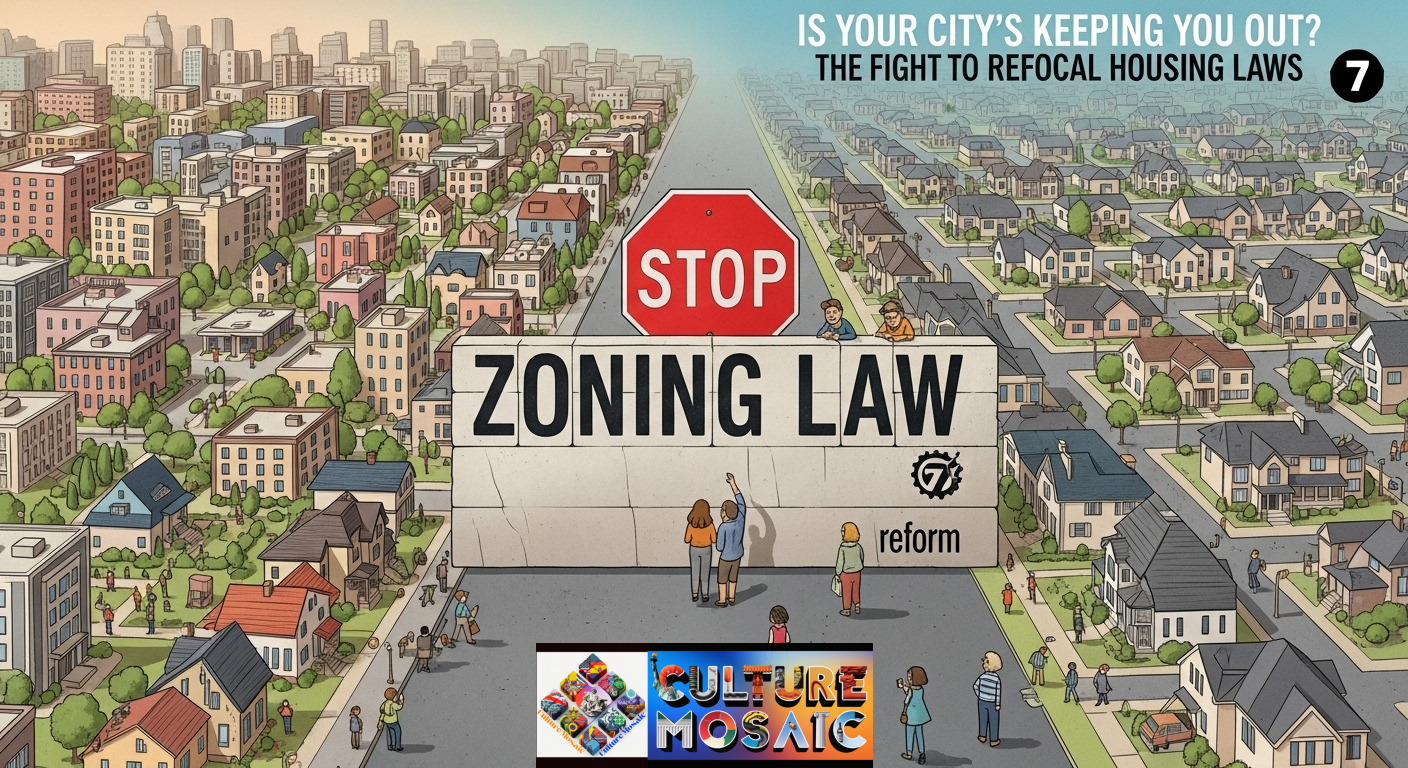Zoning Laws Housing Crisis: If you’ve been searching for an affordable apartment or trying to buy your first home, you’ve probably felt that sinking feeling when you see the prices. A one-bedroom apartment that costs more than your monthly salary. Starter homes are listed at prices your parents paid for their dream house. You’re not imagining it, and it’s not just about supply and demand in the traditional sense.
The real culprit might be hiding in plain sight at your local city council meetings. It’s called exclusionary zoning, and it’s one of the biggest drivers of the zoning laws housing crisis that’s locking millions of Americans out of affordable housing.
Understanding the Zoning Laws Housing Crisis
The zoning laws housing crisis didn’t happen overnight. It’s the result of decades of local regulations that restrict what can be built, where it can be built, and who gets to live there.
Here’s what most people don’t realize: about 75% of residential land in major American cities is zoned exclusively for single-family homes. That means no apartments, no duplexes, no small multi-unit buildings. Just standalone houses on individual lots, which happen to be the most expensive type of housing to build and buy.
These restrictions were often created with good intentions, like preserving neighborhood character or managing growth. But the unintended consequence is a severe shortage of housing options, especially affordable ones. When cities can’t build enough homes to meet demand, prices skyrocket for everyone.
The math is pretty straightforward. If your city is adding 10,000 new jobs but zoning laws only allow 2,000 new homes to be built, those 10,000 workers are competing for limited housing. The people with the most money win, and everyone else gets priced out or faces crushing rent burdens.
How Local Zoning Laws Create Housing Shortages
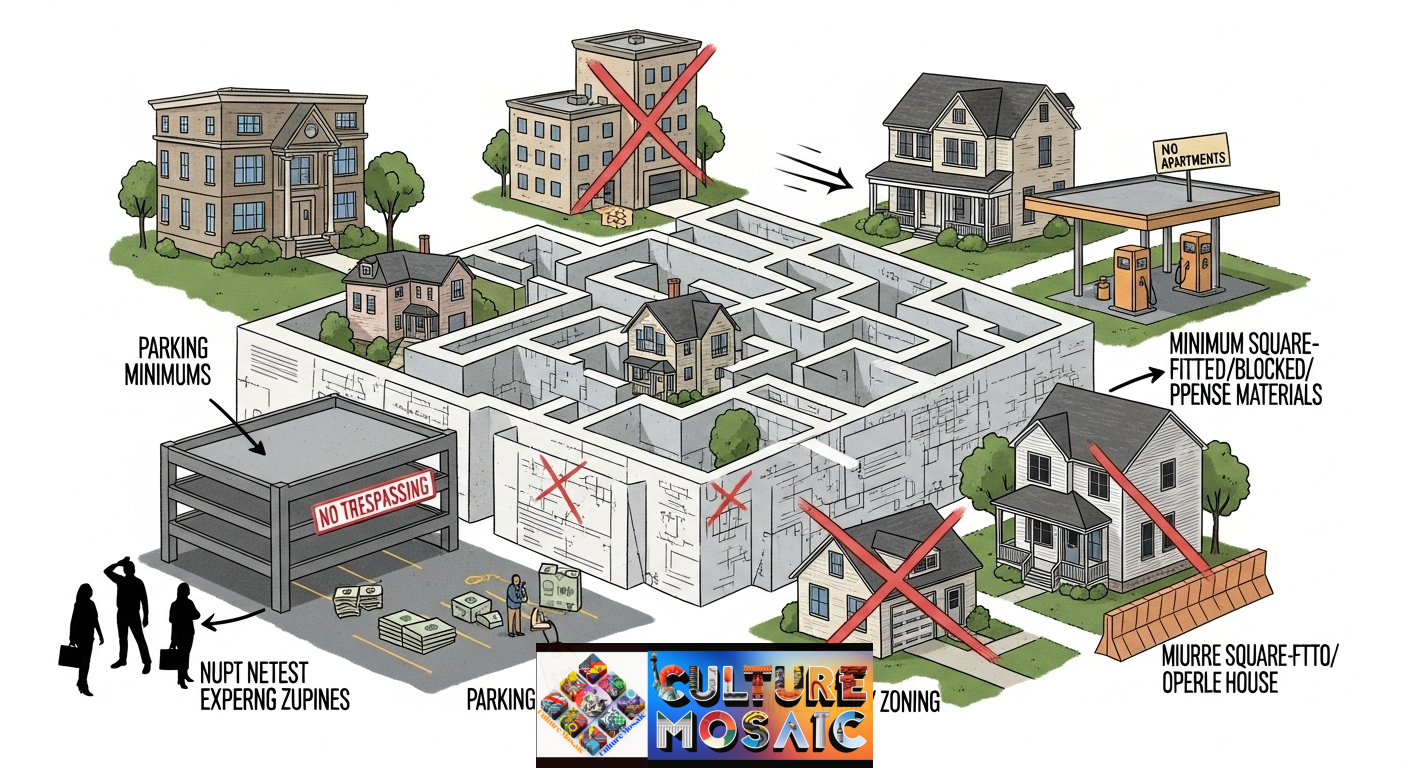
Zoning regulations control nearly every aspect of development. Minimum lot sizes, maximum building heights, parking requirements, setback rules. Each restriction might seem minor on its own, but together they create an impossible maze for anyone trying to build affordable housing.
Take parking minimums as an example. Many cities require developers to build two or more parking spaces for every apartment unit. In urban areas, underground parking can cost $50,000 to $100,000 per space to construct. That cost gets passed directly to renters and buyers, making housing more expensive even for people who don’t own cars.
Single-family zoning is even more problematic. It means a homeowner can’t convert their garage into a rental unit for their aging parent. A developer can’t replace an abandoned gas station with a small apartment building. A young family can’t buy a duplex where they live in one unit and rent out the other to help with the mortgage.
The zoning laws housing crisis is particularly acute for people just starting their careers. Entry-level housing options like studios, small apartments, and starter homes are often illegal to build under current zoning codes. This forces young people to either pay a huge percentage of their income for housing or leave cities altogether.
Some communities also use zoning to require large minimum square footage for homes, mandate expensive building materials, or ban manufactured housing. These rules explicitly prevent the construction of smaller, more affordable housing options.
The Connection Between Zoning Laws Housing Crisis and Racial Inequality

Zoning Laws Housing Crisis: We need to talk about the uncomfortable history here. Many exclusionary zoning laws have roots in racial segregation. After explicit racial covenants were outlawed, some communities turned to zoning as a legal way to maintain economic and racial exclusion.
Large-lot zoning, minimum square footage requirements, and single-family-only rules were often deliberately designed to make housing so expensive that only wealthy (predominantly white) families could afford to live there. The effects of these policies continue today.
Studies show that restrictive zoning concentrates poverty, limits access to good schools and job opportunities, and perpetuates racial wealth gaps. When people can’t afford to live near economic opportunity, it’s harder to build wealth and move up the economic ladder.
The zoning laws housing crisis isn’t just about affordability. It’s about who gets access to safe neighborhoods, quality schools, short commutes, and the social networks that help people succeed. Zoning reform is a critical tool for addressing systemic inequality.
Cities Leading Local Zoning Reform Efforts
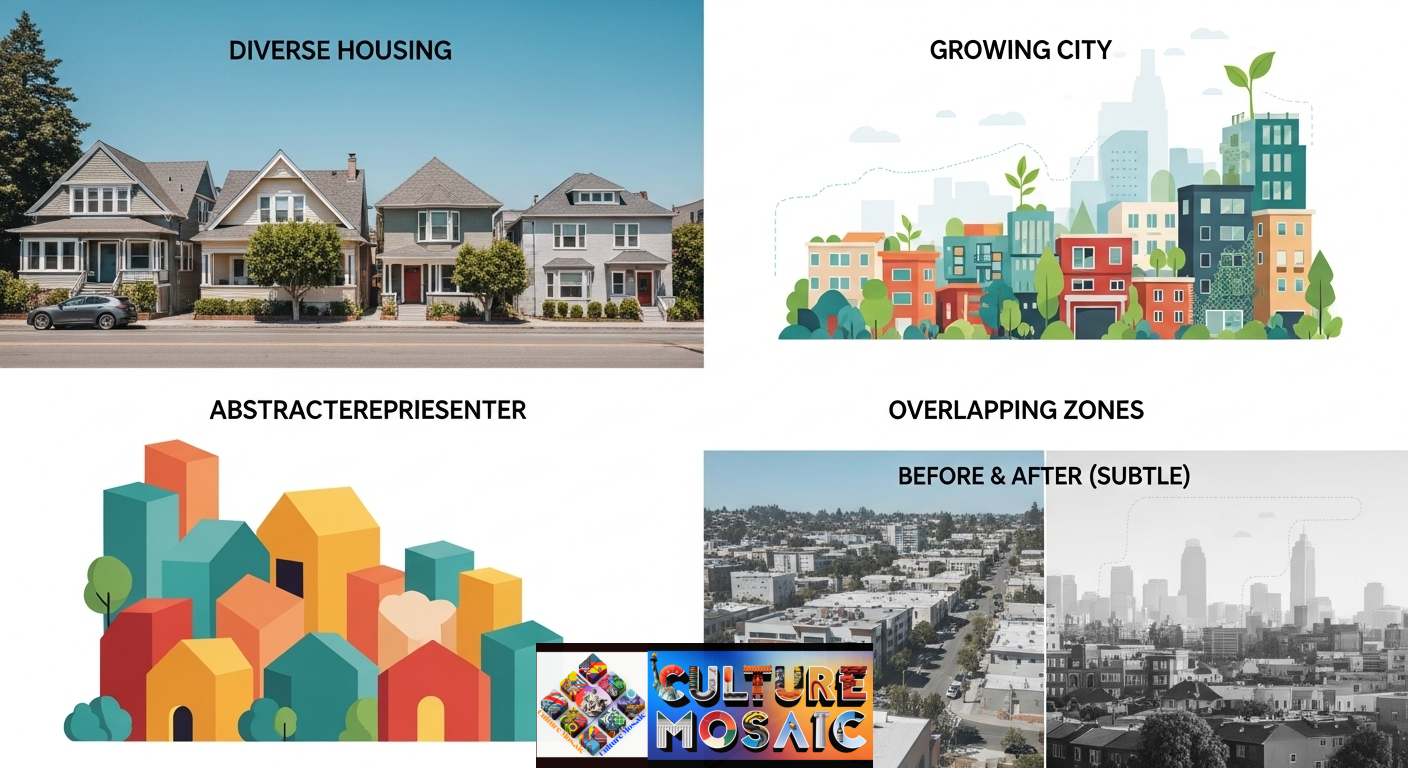
The good news is that change is happening. Several cities and states have passed meaningful zoning reforms that are beginning to address the housing shortage.
Minneapolis made national headlines in 2018 by eliminating single-family zoning citywide. Now, duplexes and triplexes are allowed on any residential lot. Early results show increased housing construction and more diverse housing options without the dramatic changes some opponents feared.
Oregon passed a statewide law allowing duplexes, triplexes, and fourplexes in neighborhoods previously zoned for single-family homes. This opened up thousands of lots for additional housing while maintaining the scale and character of existing neighborhoods.
California has been particularly aggressive with reform. The state has passed multiple laws that override local zoning restrictions to allow Accessory Dwelling Units (ADUs), sometimes called granny flats or backyard cottages. Between 2018 and 2022, ADU construction increased by over 400% in some California cities.
Berkeley, California, eliminated parking minimums for new construction, recognizing that forcing developers to build expensive parking was making housing more costly and reducing the number of homes that could be built.
These reforms share a common thread. They give homeowners more freedom to use their property, allow more diverse housing types in residential neighborhoods, and remove artificial barriers that restrict housing supply. The goal isn’t to eliminate all zoning or turn every neighborhood into Manhattan. It’s about making practical adjustments that allow more housing to be built without dramatically changing neighborhood character.
Why Local Zoning Reform Matters for the Housing Crisis
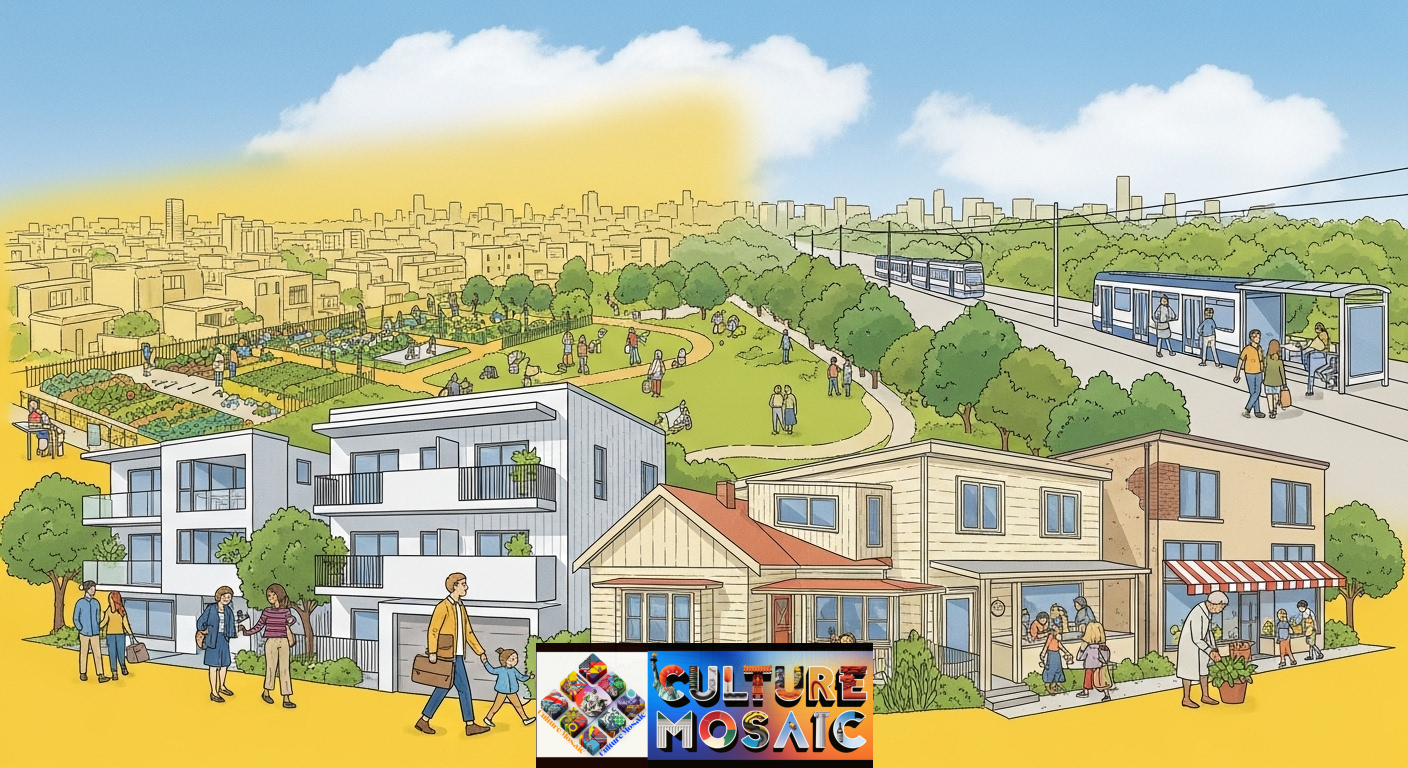
Local zoning reform directly tackles the zoning laws housing crisis by addressing the supply problem at its source. When cities allow more housing to be built in more places, several positive things happen.
First, housing prices stabilize or even decrease as supply catches up with demand. This doesn’t mean Manhattan apartments will suddenly cost the same as rural housing. It means the upward pressure on prices eases, giving people more options within their budget.
Second, people get more choices about where and how to live. Young professionals can find apartments near their jobs instead of enduring brutal commutes. Families can afford to live in neighborhoods with good schools. Older adults can downsize without leaving their communities.
Third, existing homeowners benefit too. Zoning reform allows them to build ADUs for rental income, subdivide large lots, or make other changes that increase their property’s value and usefulness. Many retired homeowners use ADU rental income to supplement fixed incomes.
Reform also supports environmental goals. When people can live closer to where they work and shop, they drive less. Allowing denser development means less sprawl, consuming farmland and natural areas. Multi-unit buildings are generally more energy efficient than single-family homes.
The economic benefits extend beyond housing costs. Cities with more housing options attract and retain young workers, supporting local businesses and tax revenue. Diverse housing options create more vibrant, walkable neighborhoods with enough residents to support local shops and restaurants.
Common Arguments Against Zoning Reform and the Reality
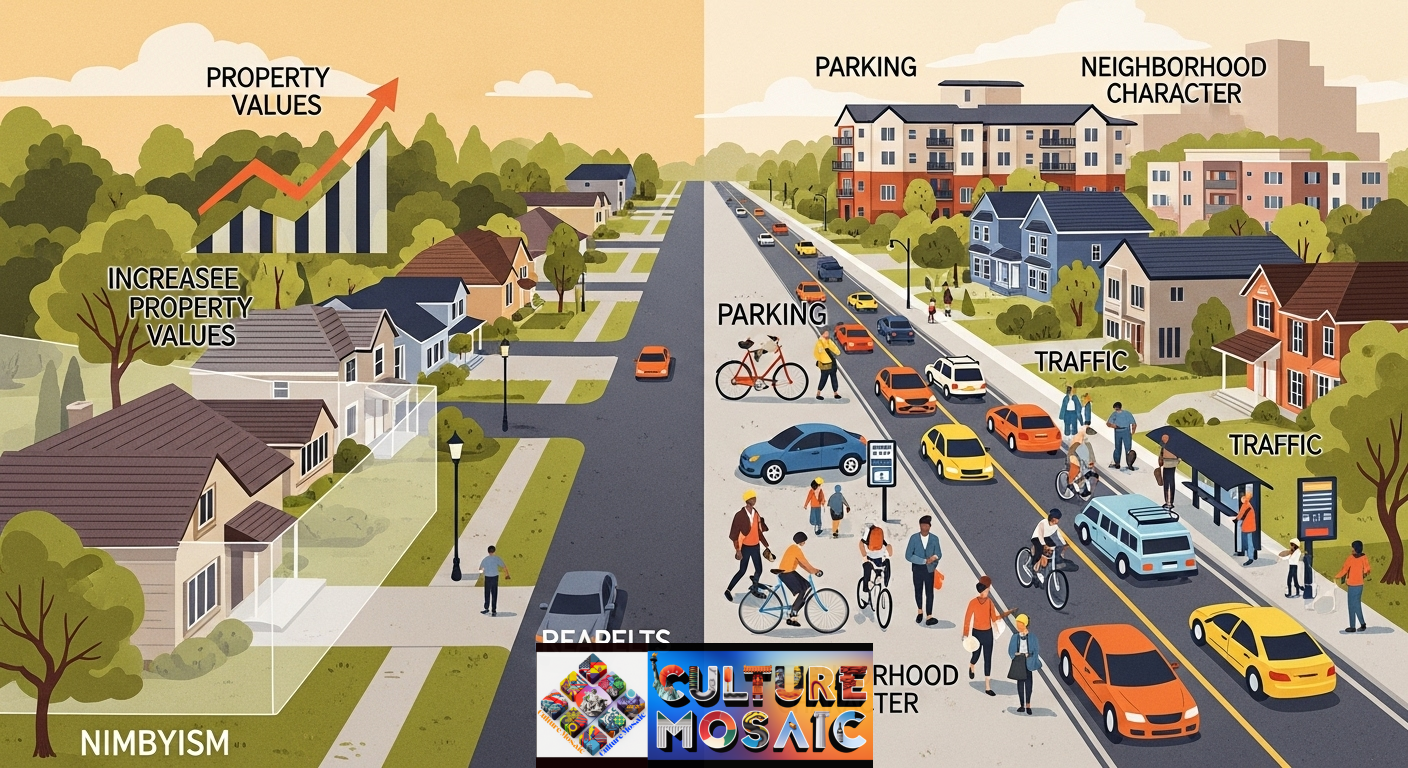
Zoning Laws Housing Crisis: Every zoning reform effort faces opposition, usually from existing homeowners worried about property values, traffic, parking, or neighborhood character. Let’s look at these concerns honestly.
The property value argument is probably the most common. Homeowners worry that allowing duplexes or apartments nearby will decrease their home values. Research consistently shows the opposite. Areas with diverse housing options typically see stable or increasing property values because they’re more desirable places to live. The housing shortage itself is a bigger threat to property values than appropriate density increases.
Parking concerns are legitimate in some cases, but often overstated. Studies show that when given the choice, developers build the parking their tenants actually need, which is often less than zoning codes require. In walkable neighborhoods near transit, many residents own fewer cars than suburban families.
Traffic worries are understandable, but traffic is caused by people, not housing. Those people exist whether or not your neighborhood allows them to live nearby. Forcing people to live far from jobs and amenities actually creates more traffic as they commute long distances. Allowing people to live near where they work and play reduces overall traffic.
The neighborhood character argument deserves respect. People genuinely value their neighborhoods and fear disruptive change. But modest reforms allowing duplexes, triplexes, and ADUs don’t transform single-family neighborhoods into downtown high-rises. Done thoughtfully, they add housing options while maintaining the general scale and feel of a neighborhood.
Some opposition to zoning reform isn’t about these practical concerns. It’s about exclusion, whether conscious or not. When people say they support affordable housing but oppose every project in their neighborhood, that’s NIMBYism (Not In My Back Yard), and it’s a major driver of the zoning laws housing crisis.
How to Get Involved in Local Zoning Reform
This is where your voice matters. Local zoning decisions happen at city council meetings, planning commission hearings, and community forums. These meetings are often sparsely attended, which means a relatively small number of people make decisions that affect thousands.
Start by learning about your city’s zoning code. Most cities publish their zoning maps and codes online. Look up your address and see what’s allowed in your neighborhood. You’ll probably be surprised by how restrictive the rules are.
Attend local planning meetings. City councils and planning commissions hold regular public hearings on zoning issues. You can speak during public comment periods. Your testimony doesn’t need to be long or technical. Personal stories about your housing search or how zoning restrictions affect your life can be powerful.
Connect with local housing advocacy groups. Organizations like YIMBY (Yes In My Back Yard) groups, affordable housing coalitions, and neighborhood associations are working on zoning reform in many cities. They can help you understand local issues and coordinate advocacy efforts.
Contact your elected officials directly. City council members, county commissioners, and state legislators respond to constituent input. A personal email or phone call explaining how the zoning laws housing crisis affects you can influence their votes on reform measures.
Support pro-housing candidates in local elections. Most people pay attention to presidential races but ignore local elections where zoning decisions are actually made. Research candidates’ positions on housing and zoning reform before you vote.
If you’re a homeowner, your voice carries extra weight. Supporters of restrictive zoning often claim they represent neighborhood interests. When homeowners speak up for reform, it breaks that narrative and shows that many people support more housing options.
Consider building an ADU yourself if your city allows it. Every ADU built demonstrates demand for diverse housing and normalizes these options in neighborhoods. Plus, you get rental income or space for family members.
The Role of State Governments in Addressing the Zoning Laws Housing Crisis
Zoning Laws Housing Crisis: While zoning is traditionally local, states are increasingly stepping in when local governments fail to address the housing crisis. This trend reflects growing recognition that the zoning laws housing crisis requires action at multiple levels of government.
State preemption laws can override local zoning restrictions that prevent housing construction. California’s ADU laws are the most prominent example. Despite local resistance, the state required cities to allow ADUs and streamlined the approval process.
Some states are going further. Massachusetts recently passed a law requiring communities served by transit to allow multi-family housing near stations. The goal is to maximize housing near public transportation while reducing sprawl and car dependence.
Montana, not typically seen as a progressive state on land use, passed significant zoning reforms in 2023. The state now requires cities to allow “middle housing” like duplexes and townhomes in single-family zones. This bipartisan reform shows that housing scarcity affects red and blue states alike.
State involvement isn’t without controversy. Local officials often resent state mandates, arguing that communities should control their own zoning. But when local inaction creates regional housing crises, affects state economic competitiveness, and perpetuates inequality, states have legitimate interests in ensuring adequate housing supply.
Federal policy plays a role, too. The Biden administration has encouraged zoning reform through grant programs that reward communities undertaking reforms. Federal transportation funding increasingly comes with requirements to promote housing near transit.
Looking at Zoning Reform Through an Environmental Lens
The connection between the zoning laws housing crisis, and climate change might not be obvious at first, but it’s significant. Exclusionary zoning that forces sprawling development patterns is terrible for the environment.
When people can’t afford housing near jobs and amenities, they move farther out, often to car-dependent suburbs. This creates longer commutes, more driving, more emissions, and more infrastructure costs. Transportation is now the largest source of carbon emissions in the U.S., and land use patterns are a major driver.
Sprawl also consumes agricultural land and natural areas. Every year, development converts hundreds of thousands of acres of farmland and open space. Much of this sprawl is driven by zoning restrictions that prevent building adequate housing in already-developed areas.
Single-family homes are less energy efficient than multi-unit buildings. Detached houses have more exterior walls exposed to outside temperatures, requiring more heating and cooling. They consume more building materials per housing unit and require more infrastructure, like roads and utility lines.
Allowing gentle density in existing neighborhoods supports environmental goals. When you can add a duplex, triplex, or small apartment building on an existing lot, you’re housing more people without consuming additional land. These neighborhoods often have established trees and vegetation that provide shade and absorb carbon.
Climate adaptation matters too. As extreme weather becomes more common, dense, walkable neighborhoods with diverse housing options prove more resilient. Residents aren’t completely car-dependent if flooding or wildfires close roads. Mixed-use neighborhoods with housing and shops create community networks that help during emergencies.
The Economics Behind Zoning Laws Housing Crisis
Understanding the economics helps explain why the zoning laws housing crisis has become so severe and why market forces alone can’t solve it.
Basic economics says that when demand exceeds supply, prices rise. That’s exactly what’s happening with housing. But zoning restrictions prevent the normal market response where high prices would trigger new construction until supply meets demand.
Imagine if only 100 sandwiches could be made per day in a city of 10,000 hungry people. Sandwich prices would skyrocket. That’s essentially what happens with housing when zoning limits how many homes can be built.
Restrictive zoning creates artificial scarcity that inflates both home prices and rents. Homeowners benefit from appreciation, but everyone else suffers. Young people can’t save for down payments. Families spend 40% or 50% their income on rent. Workers sleep in cars because they can’t afford housing near their jobs.
The filtering theory of housing explains another economic problem. Normally, as new market-rate housing is built, higher-income people move into it, freeing up older, more affordable housing for lower-income people. Zoning restrictions that prevent new construction break this filtering process, forcing everyone to compete for existing housing.
Construction costs have increased, but they’re not the main driver of unaffordable housing. Land costs driven by zoning scarcity are the bigger factor. In restrictive zoning environments, land prices can represent 50% to 80% of total housing costs.
Developers respond rationally to zoning restrictions by building only luxury housing when they do manage to get approvals. If regulations make it difficult and expensive to build anything, developers focus on high-end projects with the best profit margins. This reinforces the shortage of entry-level and middle-income housing.
Real Stories from the Zoning Laws Housing Crisis
Zoning Laws Housing Crisis: Abstract discussions of policy don’t capture the human impact of the zoning laws housing crisis. Real people are affected every day.
Sarah, a teacher in Austin, spends $1,400 per month for a studio apartment, about 45% of her take-home pay. She’d like to buy a home but can’t save for a down payment while paying such high rent. The starter homes that do exist are in distant suburbs, which would mean a 90-minute commute each way to her school.
Marcus and Jennifer were priced out of the Bay Area despite good tech jobs. They moved to Portland seeking affordability but found similar problems. Single-family zoning meant limited housing options near Marcus’s office. They settled for a longer commute and higher transportation costs, eating into the money they thought they’d save.
Robert, a retired homeowner in Minneapolis, wanted to build an ADU for rental income on his paid-off property. Before zoning reform, this was illegal. After Minneapolis eliminated single-family zoning, he built a small cottage in his backyard. The rental income supplements his Social Security and provides affordable housing for a graduate student.
Elena couldn’t find housing she could afford near her community college. The area was zoned exclusively for single-family homes priced far beyond her budget. She commutes nearly two hours each way by bus, cutting into study time and making it harder to succeed in her classes.
These aren’t edge cases. Millions of Americans face similar situations. The zoning laws housing crisis affects teachers, nurses, service workers, students, young professionals, and increasingly, middle-class families who never expected housing affordability to be their biggest financial challenge.
What Does Successful Zoning Reform Look Like?
Effective zoning reform isn’t about eliminating all regulations or dramatically transforming every neighborhood overnight. It’s about making strategic changes that significantly increase housing supply while respecting community character.
Legalizing “missing middle” housing is crucial. This includes duplexes, triplexes, fourplexes, townhomes, and small apartment buildings. These housing types were common in pre-1940s neighborhoods but were later banned by zoning. Bringing them back adds density without high-rises.
Allowing ADUs gives homeowners flexibility and creates naturally affordable housing. ADUs are typically rented below market rate because homeowners aren’t trying to maximize profit the way corporate landlords do. They provide income for homeowners while adding housing supply.
Eliminating or dramatically reducing parking minimums removes a major cost barrier to housing construction. In walkable areas or near transit, mandating parking creates expense without a corresponding benefit.
Streamlining approval processes speeds up housing construction and reduces costs. When getting permits requires years of reviews and multiple hearings, only large developers with deep pockets can afford to build. Simpler processes enable smaller projects and more diverse developers.
Upzoning near transit is particularly effective. Allowing taller buildings and greater density within walking distance of transit stations maximizes infrastructure investments while reducing car dependence.
Successful reform also includes design standards that ensure new construction fits the neighborhood context. Height limits, setback requirements, and architectural guidelines can maintain character while allowing more housing.
Overcoming NIMBYism in Your Community
NIMBY opposition is often the biggest obstacle to addressing the zoning laws housing crisis. People who theoretically support affordable housing fight specific projects in their neighborhoods.
Understanding NIMBY psychology helps. People aren’t necessarily selfish or malicious. They’re often experiencing loss aversion, a psychological bias where potential losses feel more significant than equivalent gains. The uncertain impacts of new housing feel threatening even if objective analysis shows benefits.
Status quo bias is powerful, too. People prefer things to stay as they are, even when the status quo isn’t working well. Change feels risky, and zoning reform represents change.
Effective advocacy addresses these psychological factors. Show how reform benefits everyone, including existing residents. Emphasize that neighborhoods will remain fundamentally similar, just with more housing options and neighbors.
Use local examples when possible. If your city has already approved some duplexes or ADUs, point to them. Show that the sky didn’t fall. Properties maintained their value. The neighborhood adapted easily.
Frame reform positively. Instead of “allowing duplexes,” talk about “giving homeowners more freedom to use their property.” Instead of “increasing density,” discuss “welcoming new neighbors” or “supporting local businesses with more customers.”
Build diverse coalitions. Young people, renters, and people struggling with housing costs have obvious interests in reform. But parents wanting their adult children to afford to live nearby, older adults wanting to downsize without leaving their community, and business owners needing workforce housing are natural allies, too.
Personal stories matter more than statistics. Policy papers and economic studies are important, but nothing moves people like hearing from a young family who can’t afford to live in their hometown or a teacher sleeping in her car.
The Future of Local Zoning Reform
Zoning Laws Housing Crisis: The momentum behind zoning reform is building. More states and cities are recognizing that addressing the zoning laws housing crisis requires fundamental changes to land use regulations that have been in place for decades.
Technology is playing a role. Organizations are mapping restrictive zoning practices, making it easier to see how regulations limit housing. Advocacy groups use data visualization to show how much housing could be built if restrictions were lifted.
Generational change matters. Younger generations who grew up during the housing crisis are more supportive of reform than older homeowners. As this demographic becomes a larger share of the electorate, political dynamics shift.
The COVID-19 pandemic changed some attitudes, too. Remote work reduced the necessity of living in specific locations, but also highlighted how zoning restrictions in desirable areas made housing unaffordable. Some people reconsidered the value of exclusionary practices.
Economic pressures continue mounting. As housing costs consume larger shares of household budgets, more people are affected and motivated to support change. The crisis isn’t just hitting the lowest-income residents anymore. It’s reaching into the middle class and affecting families who should be comfortable.
Climate concerns are pushing reform, too. Young voters especially recognize that sprawling development patterns driven by exclusionary zoning are environmentally unsustainable. Building walkable, efficient neighborhoods isn’t just about housing. It’s about climate action.
Expect more state involvement. When local governments consistently fail to address regional housing crises, states will increasingly preempt local authority. This trend will probably continue regardless of which party controls state governments, because housing scarcity affects everyone.
The next decade will likely see significant changes to zoning practices that have dominated for the past 80 years. Whether reform happens quickly enough to address the crisis before more damage is done depends largely on whether ordinary people get involved in local advocacy.
Taking Action on the Zoning Laws Housing Crisis
The zoning laws housing crisis won’t solve itself. Markets can’t fix a problem caused by regulations that prevent markets from working. It requires political action, which means it requires you.
Start small if large-scale advocacy feels intimidating. Talk to friends and family about how zoning affects housing costs. Many people don’t understand this connection. Raising awareness is valuable.
Follow local planning and housing issues. Most cities have email lists for planning commission and city council meetings. Sign up and stay informed about what’s being discussed in your community.
When housing or zoning items appear on meeting agendas, attend if possible or submit written comments. Public input shapes decisions more than people realize, especially when few people participate.
Vote in local elections with housing and zoning in mind. Research candidates’ positions. Support people who understand that addressing the housing crisis requires zoning reform, not just subsidies and hoping for the best.
If you own property, consider what you might do differently if regulations allowed it. Would you build an ADU? Convert an oversized single-family home to a duplex? Sharing your aspirations with policymakers helps them understand how regulations constrain housing supply.
Support businesses and organizations working on housing advocacy. Many nonprofit groups need volunteers and funding to continue their work. Your time or money can make a real difference.
Don’t be discouraged by setbacks. Zoning reform is challenging because it challenges powerful interests and familiar ways of thinking. Change happens incrementally. Every small victory creates momentum for larger reforms.
The zoning laws housing crisis is solvable, but only if enough people demand solutions. Your city council responds to voters. Your state legislature responds to constituents. When enough people make clear that housing affordability matters and zoning reform is necessary, change happens.
Your voice matters. Use it.
FAQs About zoning laws housing crisis
What exactly are zoning laws, and how do they affect housing?
Zoning laws are local regulations that control what types of buildings can be constructed in different areas. They dictate whether land can be used for single-family homes, apartments, businesses, or other purposes. These laws directly affect housing by limiting how many homes can be built and what types are allowed. When zoning is too restrictive, especially rules requiring only single-family homes on large lots, it prevents the construction of affordable housing options and creates artificial scarcity that drives up prices.
How does the zoning laws housing crisis specifically impact young people and first-time homebuyers?
The zoning laws housing crisis hits young people particularly hard because restrictive zoning often bans the exact types of housing they need: small apartments, starter homes, and affordable rental units. With limited supply and high demand, prices skyrocket beyond what entry-level salaries can afford. Young professionals often find themselves spending 40% to 50% of their income on rent, making it impossible to save for a down payment or build wealth. Many end up living with parents longer, moving to distant suburbs with brutal commutes, or leaving their preferred cities entirely.
Can zoning reform really make housing more affordable, or is it just about helping developers?
Zoning reform genuinely increases housing affordability by allowing more homes to be built where people want to live. When supply increases relative to demand, price pressures ease. Cities that have implemented reforms like Minneapolis, Portland, and various California cities are seeing measurable increases in housing construction. While developers do benefit from being able to build more, the bigger beneficiaries are renters who see more options and stabilizing prices, homeowners who gain flexibility to build ADUs or make other property improvements, and communities that can retain workers and young families who might otherwise be priced out.
What can I actually do to support zoning reform in my community?
Start by attending local city council and planning commission meetings where zoning decisions happen. Public comment from residents carries significant weight, and these meetings are often sparsely attended. Contact your local elected officials directly to express support for reforms like allowing ADUs, legalizing duplexes and triplexes, or eliminating parking minimums. Vote in local elections for candidates who support pro-housing policies. Join or support local housing advocacy organizations. Even small actions like educating friends about how zoning affects housing costs help build momentum for change.
Won’t allowing more housing types in my neighborhood hurt property values and increase traffic?
Research consistently shows that allowing diverse housing types doesn’t hurt property values and often increases them by making neighborhoods more desirable. Areas with varied housing options tend to be more walkable, have better access to amenities, and attract more residents who support local businesses. As for traffic, restricting housing in your neighborhood doesn’t make those people disappear. They just live farther away and drive longer distances, creating more overall traffic. Allowing people to live near where they work and shop actually reduces traffic by shortening or eliminating commutes. Modest density increases through duplexes, ADUs, and small apartment buildings won’t transform quiet residential streets into highways.

